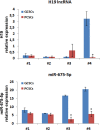Cancer stem cells from peritumoral tissue of glioblastoma multiforme: the possible missing link between tumor development and progression
- PMID: 29963265
- PMCID: PMC6021333
- DOI: 10.18632/oncotarget.25565
Cancer stem cells from peritumoral tissue of glioblastoma multiforme: the possible missing link between tumor development and progression
Abstract
In glioblastoma multiforme (GBM), cancer stem cells (CSCs) are thought to be responsible for gliomagenesis, resistance to treatment and recurrence. Unfortunately, the prognosis for GBM remains poor and recurrence frequently occurs in the peritumoral tissue within 2 cm from the tumor edge. In this area, a population of CSCs has been demonstrated which may recapitulate the tumor after surgical resection. In the present study, we aimed to characterize CSCs derived from both peritumoral tissue (PCSCs) and GBM (GCSCs) in order to deepen their significance in GBM development and progression. The stemness of PCSC/GCSC pairs obtained from four human GBM surgical specimens was investigated by comparing the expression of specific stem cell markers such as Nestin, Musashi-1 and SOX2. In addition, the growth rate, the ultrastructural features and the expression of other molecules such as c-Met, pMet and MAP kinases, involved in cell migration/invasion, maintenance of tumor stemness and/or resistance to treatments were evaluated. Since it has been recently demonstrated the involvement of the long non-coding RNAs (lncRNAs) in the progression of gliomas, the expression of H19 lncRNA, as well as of one of its two mature products miR-675-5p was evaluated in neurospheres. Our results show significant differences between GCSCs and PCSCs in terms of proliferation, ultrastructural peculiarities and, at a lower extent, stemness profile. These differences might be important in view of their potential role as a therapeutic target.
Keywords: H19 lncRNA and miR-675-5p; glioblastoma cancer stem cells; peritumoral cancer stem cells; proliferation and invasiveness markers; stemness markers.
Conflict of interest statement
CONFLICTS OF INTEREST The authors declare no conflicts of interest.
Figures






Similar articles
-
Analysis of angiogenesis related factors in glioblastoma, peritumoral tissue and their derived cancer stem cells.Oncotarget. 2016 Nov 29;7(48):78541-78556. doi: 10.18632/oncotarget.12398. Oncotarget. 2016. PMID: 27705944 Free PMC article.
-
TGFβ-Responsive HMOX1 Expression Is Associated with Stemness and Invasion in Glioblastoma Multiforme.Stem Cells. 2016 Sep;34(9):2276-89. doi: 10.1002/stem.2411. Epub 2016 Jul 4. Stem Cells. 2016. PMID: 27354342 Free PMC article.
-
Cytomegalovirus infection induces a stem cell phenotype in human primary glioblastoma cells: prognostic significance and biological impact.Cell Death Differ. 2016 Feb;23(2):261-9. doi: 10.1038/cdd.2015.91. Epub 2015 Jul 3. Cell Death Differ. 2016. PMID: 26138445 Free PMC article.
-
Pathological and Molecular Features of Glioblastoma and Its Peritumoral Tissue.Cancers (Basel). 2019 Apr 3;11(4):469. doi: 10.3390/cancers11040469. Cancers (Basel). 2019. PMID: 30987226 Free PMC article. Review.
-
The emerging role of tumor-suppressive microRNA-218 in targeting glioblastoma stemness.Cancer Lett. 2014 Oct 10;353(1):25-31. doi: 10.1016/j.canlet.2014.07.011. Epub 2014 Jul 17. Cancer Lett. 2014. PMID: 25042866 Review.
Cited by
-
Novel approaches for glioblastoma treatment: Focus on tumor heterogeneity, treatment resistance, and computational tools.Cancer Rep (Hoboken). 2019 Dec;2(6):e1220. doi: 10.1002/cnr2.1220. Epub 2019 Nov 11. Cancer Rep (Hoboken). 2019. PMID: 32729241 Free PMC article.
-
Molecular and Clinical Insights into the Invasive Capacity of Glioblastoma Cells.J Oncol. 2019 Jul 29;2019:1740763. doi: 10.1155/2019/1740763. eCollection 2019. J Oncol. 2019. PMID: 31467533 Free PMC article. Review.
-
A Tumor Suppressor Gene, N-myc Downstream-Regulated Gene 1 (NDRG1), in Gliomas and Glioblastomas.Brain Sci. 2022 Apr 3;12(4):473. doi: 10.3390/brainsci12040473. Brain Sci. 2022. PMID: 35448004 Free PMC article. Review.
-
Identification of CD44 as a Reliable Biomarker for Glioblastoma Invasion: Based on Magnetic Resonance Imaging and Spectroscopic Analysis of 5-Aminolevulinic Acid Fluorescence.Biomedicines. 2023 Aug 24;11(9):2369. doi: 10.3390/biomedicines11092369. Biomedicines. 2023. PMID: 37760811 Free PMC article.
-
Glioblastoma Multiforme Selective Nanomedicines for Improved Anti-Cancer Treatments.Pharmaceutics. 2022 Jul 12;14(7):1450. doi: 10.3390/pharmaceutics14071450. Pharmaceutics. 2022. PMID: 35890345 Free PMC article.
References
-
- Denysenko T, Gennero L, Roos MA, Melcarne A, Juenemann C, Faccani G, Morra I, Cavallo G, Reguzzi S, Pescarmona G, Ponzetto A. Glioblastoma cancer stem cells: heterogeneity, microenvironment and related therapeutic strategies. Cell Biochem Funct. 2010;28:343–351. - PubMed
-
- Bao S, Wu Q, McLendon RE, Hao Y, Shi Q, Hjelmeland AB, Dewhirst MW, Bigner DD, Rich JN. Glioma stem cells promote radioresistance by preferential activation of the DNA damage response. Nature. 2006;444:756–760. - PubMed
-
- Eramo A, Ricci-Vitiani L, Zeuner A, Pallini R, Lotti F, Sette G, Pilozzi E, Larocca LM, Peschle C, De Maria R. Chemotherapy resistance of glioblastoma stem cells. Cell Death Differ. 2006;13:1238–1241. - PubMed
LinkOut - more resources
Full Text Sources
Other Literature Sources
Miscellaneous

